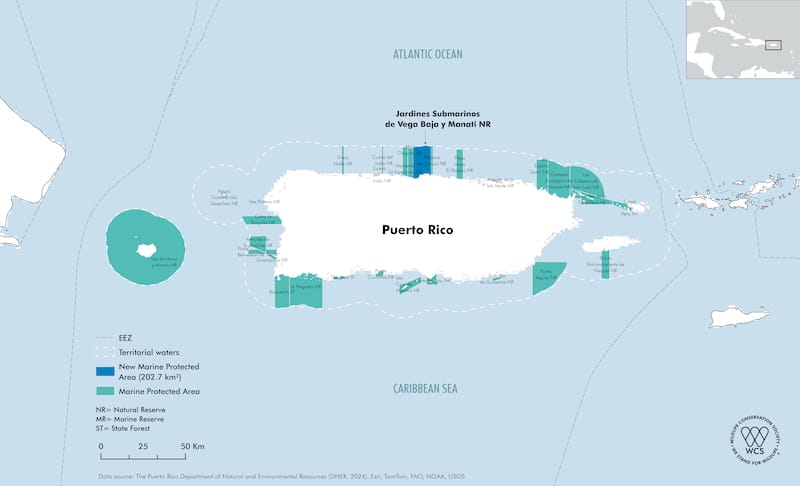This post was originally published on Eco Watch
After 16 years of efforts by grassroots organizations, local Puerto Rico communities are celebrating the establishment of the country’s new marine protected area (MPA), Jardines Submarinos de Vega Baja y Manatí.
The new marine reserve on Puerto Rico’s north coast will protect 77 square miles of marine biodiversity, a press release from the Wildlife Conservation Society (WCS) said. The project was a collaboration between local communities and authorities and environmental organizations.
A map of Puerto Rico’s new marine reserve protected area. Wildlife Conservation Society
More than 14 endangered species live amongst the reserve’s mangroves and seagrass beds, including the Greater Caribbean Manatee. Beneath its blue-green waters is one of the largest Elkhorn coral colonies in the Caribbean, as well as a variety of other coral species and endangered and threatened marine life, a press release from the Surfrider Foundation said.

An endangered manatee in Puerto Rico. Darryl Stansbury / U.S. Fish and Wildlife Service Southeast Region
“This is a victory for the people,” said Ricardo Laureano, leading member of nonprofit Vegabajeños Impulsando Desarrollo Ambiental Sustentable (VIDAS), in the WCS press release. “These ecosystems nourish us and sustain our quality of life. It took 16 years of hard work, starting in 2007, to get here. Over the years, we rallied neighbors, knocked on doors, and engaged local and national leaders to highlight the critical need to protect this Reserve.”
A local ecotourism industry and small-scale fisheries flourish in the area, and local communities have hope that the formal co-management of the Jardines sanctuary as an MPA will safeguard its waters as a thriving source of income and food for generations to come.
A coalition of local groups led by VIDAS — including Sociedad de Ambiente Marino, Surfrider Puerto Rico, Puerto Rico Sea Grant and Para la Naturaleza — brought the Jardines conservation movement to fruition, with the support of WCS and other international partners.

“The Jardines MPA represents a critical point of connectivity within the greater Caribbean. Since 2018, WCS has joined forces with the Caribbean Biological Corridor (CBC) – an intergovernmental platform that brings together the countries of the Greater Antilles – to advance and scale up marine conservation in the region. As part of this initiative, WCS supported local partners in Puerto Rico that worked with VIDAS to strengthen the Jardines MPA proposal and bring it across the finish line,” WCS said. “As the coalition looks ahead, securing funding and scientific support for designing a participatory management process is crucial. A formal legal framework, co-management agreements with local agencies, and a recurring budget will be essential for the project’s longevity.”
The next step for the Jardines MPA will be developing a co-management strategy.
“Our dream is for Jardines to be co-managed by the people who know it best — the local communities,” Mariela Declet-Perez, leader of Descendants United for Nature, Adaptation, and Sustainability, said in the WCS press release. “We aim to create co-management agreements that balance sustainable resource use, conservation, research, and eco-tourism. This will take time, but we are committed to supporting VIDAS and our local partners to ensure long-term success.”
Community leaders hope the success of the MPA inspires others to conserve their natural wonders.
“To other coastal communities around the world, our message is clear: never stop fighting for your ecosystems,” Laureano said.
The post Puerto Rico’s New Marine Reserve Will Protect More Than 14 Endangered Species appeared first on EcoWatch.





0 Comments